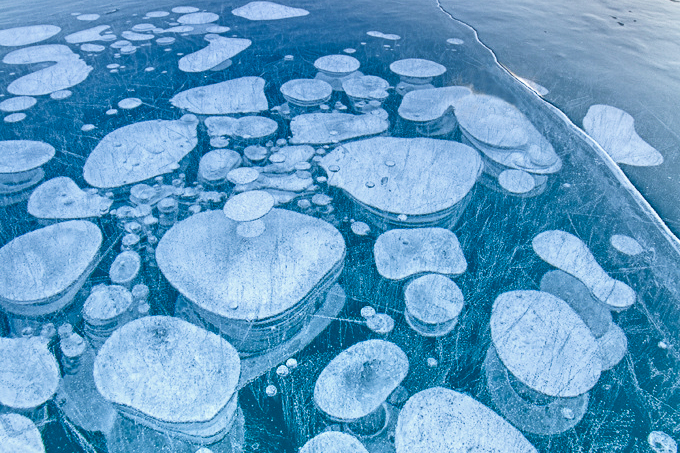Arctic methane lid may be fracturing
 In what may point to an alarming new driver for global warming, scientists have found unexpected amounts of methane emerging from the Arctic Ocean between cracks and open leads amid pack ice far out to sea.
In what may point to an alarming new driver for global warming, scientists have found unexpected amounts of methane emerging from the Arctic Ocean between cracks and open leads amid pack ice far out to sea.
Samples taken during five pole-to-pole research flights during 2009 and 2010 found the super greenhouse-gas methane, or CH4, appearing in concentrations about half a percent above background levels — a surprising level given the distance from known sources like thawing permafrost and frozen hydrates on the seabed, according to new paper published in the online edition of Nature Geoscience.
Patches of exposed ocean were apparently exhaling methane within 600 miles of the geographic North Pole, hundreds of miles beyond Alaska’s polar shore.
“These observations show a clear signature of CH4 emissions from surface water distributed across the Arctic Ocean north of the Chukchi and Beaufort seas, spanning many months of the year,” wrote lead author Eric Kort with NASA’s Jet Propulsion Laboratory, along with 11-coauthors, in the paper. “We suggest that the surface waters of the Arctic Ocean represent a potentially important source of methane, which could prove sensitive to changes in sea-ice cover.”
Even worse, a climate warming process involving one of the most potent greenhouse gases may already be feeding on itself, the scientists said, since upper layers of the Arctic Ocean are known to be saturated with methane.
As melting sea ice exposes more ocean water to the air, methane production may increase — which in turn will trigger ever larger emissions, eventually leading to even greater loss and fracturing of ice, Kort explained in this JPL story discussing the results.
“While the methane levels we detected weren’t particularly large, the potential source region, the Arctic Ocean, is vast. So our finding could represent a noticeable new global source of methane,” Kort said.
Arctic morphs into big greenhouse gas source
The paper — Atmospheric observations of Arctic Ocean methane emissions up to 82 degrees north — is part of a growing body of research that fingers the Arctic as an unexpected producer of greenhouse gases as permafrost thaws and sea ice shrinks.
The natural presence of gases such as carbon dioxide and methane in the air helps keep Earth warm enough for life to exist. Solar radiation warms the planet, and these gases absorb the heat and slow its loss back into space, acting somewhat like glass in a greenhouse, hence the nickname.
Earth’s CO2 level has been rising for more than a century and is now more than 394.45 parts per million — the highest reading ever taken during the Northern Hemisphere spring, according to the latest measurements posted by the Mauna Loa Observatory in Hawaii.
While most scientists blame the increase on the burning of fossil fuels, other factors have begun to play larger roles.
For instance, thawing Arctic permafrost will likely dump an extra 68 billion tons of carbon into the air before 2100, transforming the Far North into one of the world’s prime sources for climate-changing greenhouse gases, according to a study published in the Proceedings of the National Academy of Sciences. That’s about 7.5 years of emissions by every person on Earth at current rates. And much of this new carbon will emerge in the form of methane.
Just last fall, the Annual Greenhouse Gas Index warned that atmospheric concentrations of methane had recently begun a steep climb after a decade of stability. “Pound for pound, methane is 25 times more potent as a greenhouse gas than carbon dioxide,” the NOAA story notes.
Why does methane — created naturally by decay and digestion — get such bad press? Because CH4 has much greater capacity than CO2 to absorb and hold infrared radiation. Balance methane’s lifespan in the atmosphere against its innate heat-holding ability, and you end up with a Global Warming Potential that’s more than 20 times greater than CO2 over 100 years. There are other super greenhouse gases out there, too, but none as threatening as methane.
“The Arctic is home to large reservoirs of methane, in the form of permafrost soils and methane hydrates, which are vulnerable to destabilization in a warming climate,” the scientists explained in the paper. “Furthermore, methane is produced in the surface ocean and the surface waters of the Arctic Ocean are supersaturated with respect to methane.”
Several recent discoveries suggest that methane sources on bottom of the ocean have already been producing much faster than once thought.
“A Russian research ship recently made a terrifying discovery — huge plumes of methane bubbles rising to the surface from the seabed,” the London Daily Mirror reports.
“‘We found more than 100 fountains, some more than a kilometer across,’ said Dr. Igor Semiletov, (with the International Arctic Research Center in Fairbanks.) ‘These are methane fields on a scale not seen before. The emissions went directly into the atmosphere.'”
While the image of methane wafting off the sea surface might not be as cinematic as seabed “fountains” burping up gobs of nasty gas, the implications of the new research may be just as alarming — given the decades-long shrink in sea ice extent and thickness.
Kort and his team found no enhanced levels of methane when they flew over solid ice. But the methane showed up wherever the pack had cracked or pulled back to expose ocean water to the air. The emissions seemed to be largest in April and early November.
“Large areas of open water are not necessary, as fluxes of CH4 from open leads were repeatedly observed and strong emissions were observed over fractured floating ice,” they wrote.
The polar sea’s methane puzzle
Where is it all coming from?
“The team detected no carbon monoxide in the atmosphere that would point to possible contributions from human combustion activities,” the scientists explained in the JPL story. “In addition, based on the time of year, location and nature of the emissions, it was extremely unlikely the methane was coming from high-latitude wetlands or geologic reservoirs.”
In the end, Kort and his colleagues say they remain unsure what’s producing the methane. Still, biological production by tiny marine life near ice floes may be the most likely source.
“Since the 1970s, scientists have known that ocean surface waters are rich in methane. It seems to be made by marine bacteria trying to survive in waters that don’t have many nutrients in the form of nitrates,” explained Michael Marshall in this story about the research posted by New Scientist.
“Water in the Arctic Ocean doesn’t mix well, so the water near the surface tends to remain there. Consequently, the methane ends up trapped near the surface. In other oceans, it would get broken down through reaction with oxygen or consumed by methanotrophic bacteria, but the cold weather helps to preserve it.”
The polar sea is vast, and its methane lid has been growing more fractured as the decades pass. Future implications are jarring.
“As Arctic sea ice cover continues to decline in a warming climate, this source of methane may well increase,” Kort warned in this story. “It’s important that we recognize the potential contribution from this source of methane to avoid falsely interpreting any changes observed in Arctic methane levels in the future.”
Contact Doug O’Harra at doug(at)alaskadispatch.com
For more stories from Alaska Dispatch, click here



